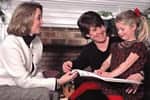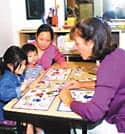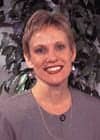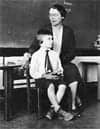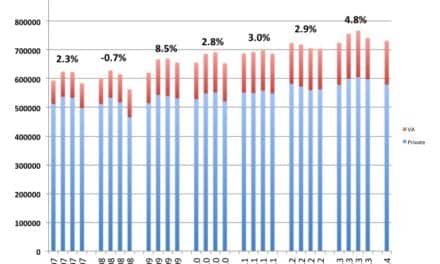CLARKE-School for the Deaf/Center for Oral Education emphasizes communication skills and advanced scholastic programs for its students.

Like most small cities, Northampton, Mass, has much to offer—art galleries, museums, restaurants, shops. But nestled among the area’s four colleges—Amherst, Hampshire, Mount Holyoke, Smith—and the University of Massachusetts is a facility that makes the town unique. It is home to the “Harvard” of deaf schools—CLARKE-School for the Deaf/Center for Oral Education. “We’re not like Harvard because we do not have that kind of money,” says Dennis Gjerdingen, president of the Clarke School. “One of the things I like best about our program is that the typical IQ here comes out to 101, so [the students are] very average. The common degree of deafness here is profoundly deaf, so we deal with very deaf kids. Given that, the accomplishments we’ve had with these kids is certainly as great or greater than what Harvard has been able to do in the college arena.”
Adjoining the campus of Smith College, CLARKE opened its doors in 1867 (see sidebar, “A Notable History”) with 20 students. Today, in addition to its Northampton campus, the school operates satellite campuses in New York, Boston, Philadelphia, and Jacksonville, Fla. It currently has about 166 students enrolled at all of its campuses. In addition to the satellite programs maintained by CLARKE, the school also has helped set up 16 other deaf programs. At all of its campuses combined, the school employs 170. The Northampton campus is home to 18 residential students.
CLARKE follows an auditory/oral model, focusing on communication skills. Gjerdingen is quick to point out that CLARKE’s emphasis is on education and the positive and not therapy and the negative. “In our field we have a tendency to try to work at what [the students are] worst at,” he says. “We find that the difference [between] an education-based program and a therapy-based program is that therapy gears itself toward what’s wrong, the education program gears itself toward what’s right. And you give those kids a chance to succeed at things. Maybe it’s drama, maybe it’s basketball, maybe it’s chess, but find out what’s good with those kids.”
Classes at CLARKE are small, averaging from four to eight students. Students can attend the school from preschool through eighth grade. And though the pace might be slower than in a hearing school, the classes follow a normal school curriculum. For instance, in the Model Middle School Program, the curriculum is the same Massachusetts Frameworks model that hearing schools follow, which requires students to pass a standardized test in 10th grade. “Most deaf kids graduate from high school reading less than fourth-grade level—that’s just a fact,” says Gjerdingen. “The majority of our kids go on to college. They’ve gone on to more than 200 colleges and universities and postsecondary programs. They hold down jobs in all walks of life. The point is deafness doesn’t have to handicap them.” CLARKE alumni have found success in a variety of fields from teaching to architecture to medicine.
Making the Right Fit
And like its spiritual role model, Harvard, CLARKE is selective about who it allows to attend the school. The admissions process is lengthy and comprehensive. “We want to see all the records on a kid before we will even see them for an admissions evaluation,” says Gjerdingen. “There’s no sense in pretending that we’re right for all kids. We’re really not. We very often see kids who have come out of sign language programs [and their] brain is so used to visual information that they’re really not going to benefit from an auditory-based program.” In addition to his primary responsibilities of fund-raising, Gjerdingen still oversees all admissions personally because of the heavy emotional investment the process requires of the parents and potential students.
However, CLARKE does not close the door on the rejected students. If they can, CLARKE administrators will assist parents in finding an alternative for their child, which could include being placed in a sign language program or mainstreamed in the child’s local public school system or a private school.
When touring CLARKE, parents quickly find that it is a one-stop shop offering their child everything they need from academics to after-school activities—which include sports and the performing arts. And though parents make the final decision about whether their child attends CLARKE, it is the student who sometimes must convince their parents to send them to the school.
Mainstreaming Challenge
But teaching their students how to communicate is only part of CLARKE’s goal; fostering independence is the rest of the equation.
Part of nurturing that independence is preparing students to leave CLARKE for their local hearing school. It is a process that can take place at any time during a student’s tenure at CLARKE and is primarily dependent on the student’s communication base. Most of the students leave when they are ready to enter high school, a transition that the school carefully shepherds with a year-long class, “Preparation for High School.” Topics covered include everything from note taking to the student’s responsibilities as a student to problem solving. During this transitional year, students visit different kinds of high schools and are visited by CLARKE alumni who are in the mainstream.
Probably the biggest challenge facing CLARKE students in the mainstream is the fast pace of hearing schools. “When we mainstream a deaf student, we’re putting them in a program that was not designed for somebody who is unable to hear—it was designed for people who hear,” says David Manning, EdD, director of CLARKE’s Mainstream Center. “The pace is faster, the challenge is greater, communication is faster, everything about school life moves at a faster pace and there is not as much repetition, there is not as much structure, and so it’s really quite challenging for students with a hearing loss. If you put a student who’s blind in a regular school, and, at the end of the day, you ask him what they talked about, he can tell you. He may have missed some of the things that were drawn on the blackboard, but he knows what was discussed in the class. When you ask a deaf student, at the end of the day, what was talked about, you get pieces.” There are ways to minimize these challenges, says Manning, including FM systems—a wireless broadcast system connecting student and teacher—or an oral transliterator, who sits at the front of the class and mouths the teacher’s words.
Though CLARKE has been mainstreaming students for 100 years, the Mainstream Center, which employs 11, has been in existence only since 1977. About 675 students of all ages have been mainstreamed during the last 25 years.
The choice of hearing school is up to the student and their parents. Manning encourages families to look at both local public and private schools. “Even if [the parents] feel pretty certain they know what school they want their child to go to, what we’re looking for is the best fit we can find,” says Manning. “And often it’s not possible to find a best fit, so we have to try to find the best situation we can, given the particular characteristics of this case. A typical family will look at maybe three schools, and then they and their child will come to a conclusion about which one they think is most appropriate. We don’t make that decision for them. We give them information and try to guide them, answer their questions. They make the final decision.”
Mainstreaming is a two-way street. Once a school is chosen, Manning and his staff work hard to prepare it for the hearing-impaired student. “[We] help them get a better understanding of what it will be like for a student like this to come to their school, what effect it may have on the way classes operate, what kind of supports the student will need, what level of courses the student would probably best function in, and the kind of ongoing help the student will need throughout the year,” says Manning. “Our goal is to get this kid through school.”
Manning adds that most schools are open to having a deaf student. “For the most part, my experience over 25 years has been that most of the schools we’ve dealt with are perfectly willing to give this a try,” he says. “They will say openly to us, ‘We’ve never done this before, and we’re nervous about it, but we’re willing to try it if you think this is appropriate and if we will get ongoing support throughout the year.’ We really run into trouble only when the school system will not permit ongoing support to occur, and the teachers are left to find their way with this thing on their own, with no expert to talk to to get answers, then you see resentment settle in.”
CLARKE also helps to prepare the student’s future hearing classmates with a shadowing experience at the school, which allows them to understand the challenges a hearing-impaired student faces and what it is like to be different from everyone else.
Although, in many cases, the CLARKE alumnus is the only deaf student at the mainstream school, there are occasions when they may find themselves reunited with old CLARKE friends and acquaintances, which gives the new student informal mentors, a relationship that Manning allows to form naturally.
After the students leave CLARKE, Manning and his staff keep tabs on them, monitoring their progress if the parents and mainstream school requests it.
For all of the successes and benefits of mainstreaming—improving communication skills and access to a more varied academic experience—not every student can or should be mainstreamed. “There are children who are not suited for mainstreaming for a variety of reasons,” says Manning. “Sometimes their communication is not good enough. Sometimes they’re just afraid of it. Sometimes they identify with other deaf people more than they do with hearing people. There can be a number of reasons.”
This “failure” to mainstream every student does not concern Manning. “There is no right or wrong,” he says. “There are people who get the idea that mainstreaming is right and not to mainstream is wrong, and that’s not true. And what they should really be focused on is the happiness of their child. I think the most important thing for a child is to go to a school where he feels he can contribute, where he feels he can be successful, and where he feels he belongs. And if he can’t do that in a regular mainstream school, I think he should be in a program where he can have those things.”
Expert Services
The Mainstream Center also helps mainstream schools throughout New England solve academic problems facing their deaf students. “We have a long list of consulting services,” says Manning. “We will help them plan the student’s educational plan, we’ll do orientations for the staff, orientations for the specific teachers the student has, we will observe the child in class and watch the dynamics between the child and the teacher and the other kids in the class. We will help the teacher troubleshoot.” About half of the center’s current caseload is made up of students who never attended CLARKE.
And fitting with Manning’s philosophy of focusing on the happiness of the child, there are a range of solutions the consulting team may offer. “We will do anything that is necessary to support that mainstream effort,” he says. “On the other hand, if we realize this school’s doing everything it can and it’s not enough, we will tell them we think this child is not appropriately placed, and may need a program for the hearing impaired.”
Teaching the Teachers
Not only does CLARKE specialize in educating deaf children, but, since 1889, it has partnered with adjoining Smith College to educate teachers of the deaf. The yearlong, 42-credit course of study goes from June to June, and ends with the awarding of a Master of Education of the Deaf (MED) degree.
Most of the applicants are either experienced teachers or have experience in the speech and hearing/language disorders field. The average age of the students is 28. Tuition is $25,000. Of the 15 students last year—the maximum the program can accommodate—10 lived on the CLARKE campus. Living on campus not only gives students a break in tuition—housing on CLARKE is cheaper than at Smith—but helps in other ways. “There is both a pedagogical and an academic advantage in their own learning rather than just the teaching side,” says Alan Marvelli, EdD, director of the graduate teacher education program and a professor at Smith.
Like CLARKE, the program has an auditory/oral focus and follows a clinical, not cultural model. “We do a lot of work in the area of development of language, both written and spoken, looking at natural, typical processes that occur with children who hear and then how children who either don’t hear or hear differently are edu-cated and how they develop,” says Marvelli. “And how we can help them through intervention to acquire these skills, or how we can, through whatever means necessary, provide them with these skills ultimately so they can [speak and] learn to listen through either acoustic devices or implanted digital processing devices, and come to know the world in a fashion that is somewhat paralleling their hearing peers. That’s the key feature. We’re trying to give them opportunities to learn to listen, to speak, to acquire language in a way that is more like that of their peers than unlike it.”
While at CLARKE, the graduate teachers rotate through each of the grades at 7-week intervals in order to give the widest teaching experience possible.
The majority of the academic year is spent in Northampton, but twice a year—in January and May or June—the students have the opportunity to go to other schools either in the surrounding area or out of the state. The January opportunity usually finds the students heading to warmer climates, says Marvelli. A few students have even taught at programs outside of the country.
Marvelli, who went through the Smith graduate teacher education program about 40 years ago, has seen teaching methods change over the years. “When I was a graduate student in this program, we were very much a visually oriented teaching model—everybody lip-read, everybody paid attention to the face,” he says. “It’s not that you don’t do that anymore because paying attention to what’s happening on someone’s face gives a lot of information even to hearing people. However, we used to teach deaf children to watch and to lip-read…it doesn’t work that way anymore. Today we expect them to learn to listen. So the kind of teacher preparation that we’re doing is focusing on how one acquires hearing skills and listening skills. How can we emulate that effectively? How can we work with parents early on? How can we get equipment functioning for these babies so that by the time they’re 5 years old they’re acting much more like their hearing peers than deaf individuals? When I started my work in this field, the entry age for the majority of children into a school situation was about 4. And now the moment of detection is in the hospital in the neonatal clinic [through screening programs]. The intervention has moved from 4 to zero.”
Upon graduation, not all of the new teachers of the deaf go on to other schools. At least one or two a year are hired by CLARKE for one of its five campuses. Because of the school’s recent growth spurt, CLARKE hired four members of last year’s class for its Northampton campus. Many of the students use their postgraduate tenure at CLARKE as a career launching pad to other programs, staying only a year or two.
Like an Ivy League school, CLARKE is not an inexpensive proposition—the operating budget is about $10 million per year. So fund-raising is a necessity. Funds are raised through donations, grants, and other activities. The school’s endowment is just under $9 million.
Tuition ranges from a little more than $14,000 per year for the preschool program to over $35,000 per year for students living at the school. Gjerdingen admits most students’ parents cannot afford the tuition, so each student is heavily subsidized from the $6 million raised annually.
During the admissions process, the student’s ability to pay is not a condition for either admission or rejection.
The Outstanding Factor
For all of its traditions, its innovations, its successes, there is one thing that makes CLARKE stand out from other deaf schools: its faculty and staff, says Gjerdingen. “We have remarkable staff,” he says. “We have remarkable people at each of the key positions. We have remarkable teachers in our classes. More than half of our staff has been here over 20 years. As a private school, we’re certainly not in a position to pay the kind of salaries that public school teachers make, so people work here out of dedication. It’s those people that make CLARKE great.”
| A Notable History
Often referred to as the “Harvard” of schools for the deaf and hard-of-hearing, CLARKE boasts an impressive pedigree of former students, teachers, and advocates.
CLARKE has had a notable history, playing a significant role in the lives of United States presidents, Wall Street tycoons, and American icons. The motivation for establishing CLARKE was personal, coming in the wake of the scarlet fever that caused the deafness of founder Gardiner Greene Hubbard’s daughter Mabel in the early 1860s. Though Hubbard’s plan to start a deaf school was generally supported, it was blocked by the Massachusetts legislature primarily through the efforts of Lewis J. Dudley. Dudley, who was also the father of a deaf child, branded Hubbard’s scheme as “unpractical” and “visionary.” Hubbard was able to demonstrate the practicality of establishing an oral deaf school by teaching Dudley’s 13-year-old daughter, Theresa, who had never spoken a word, “daddy” and 15 other words in 2 days. Convinced, Dudley assisted in getting the legislature to issue a charter for the school.
At the same time, it was learned that Northampton, Mass, merchant John Clarke was offering $50,000 to start a school for the deaf, a cause he supported because of his own gradual deafness. Hubbard and the school’s first principal, Harriet B. Rogers, approached Clarke about funding the school. Clarke gave Hubbard the money, reluctantly agreeing to have the school named in his honor. The Clarke School for the Deaf opened its doors in 1867, becoming the first permanent oral school for the deaf in the country. The first class had 20 students who ranged in age from 6 to 15 years old. Notable Matchmaking
CLARKE has brought other couples together, including Grace Goodhue, a teacher at CLARKE, and a young Northampton lawyer, Calvin Coolidge, who became the 30th President of the United States. The couple, who met on the CLARKE campus, was married in 1905, and continued their association with CLARKE throughout Coolidge’s presidency and beyond. Both served on the Board, with Grace serving as president from 1935 until 1952. She later headed up the Centennial Development Program from 1955 until her death in 1957. Coolidge was not the only US president involved with CLARKE. President John F. Kennedy was a frequent visitor, serving on the school’s National Committee of Sponsors from 1955 until his assassination in 1963. Financiers as well as politicians have aided the growth of CLARKE. To honor the Coolidges as they departed the White House in 1929, Wall Street Journal publisher Clarence W. Barron initiated the Coolidge Fund, a campaign to raise $2 million. Association with Smith College
In the early days, CLARKE found itself sharing its resources with Smith. “When Smith College got started, we were always good neighbors, but their professor of anatomy did not have a skeleton to use in their course, so they would come up here and borrow our skeleton,” says Dennis Gjerdingen, president of CLARKE. “There’s all these stories told of this professor walking across the street carrying this skeleton back and forth.” CLARKE has been the site of innovation almost from the start. Rogers’ successor, Caroline Yale, who remained at CLARKE for more than 40 years, was an early innovator. “Caroline Yale’s great contribution to the field was in recognizing that we [should] get the children much earlier,” says Gjerdingen, who is the school’s sixth president and has been at CLARKE since 1981. “In those days, deaf children didn’t come to school until they were 9 years old. She was the one who pioneered the idea of what we call preschooling today.” Gjerdingen has continued these innovations by broadening the scope of the school’s mission and formalized a number of its programs by establishing CLARKE’s Center for Oral Education. The notable associations have not ended with the deaths of principal benefactors. Members of the Hubbard family serve on the board to this day, and Barron’s name adorns the school’s research department. |
Chris Wolski is associate editor of Hearing Products Report.


